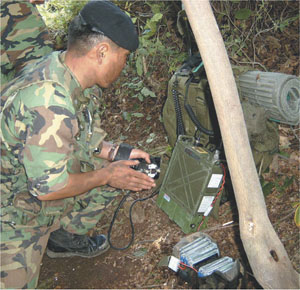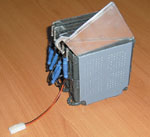Water Sparks Small Power Pack
 |
| The collapsible metal air battery was developed to meet the needs of South Korea’s special operations forces. The device is used to charge radio batteries and as an emergency power source for electronics systems such as personal digital assistants and notebook computers. |
As individual soldiers are issued more sensor and communications systems, powering this equipment has become a challenge. The default energy source, batteries, presents many logistical difficulties. Disposable batteries are the most common power providers in use, but ground forces must deal with environmental and weight issues. Rechargeable batteries are beginning to enter service, but charging them in the field remains a challenge. Military services around the world are seeking technologies that will run soldiers’ equipment without logistics complications.
An example of the effort to provide alternatives to traditional battery power is the collapsible metal air battery developed by the MEET Company Limited,
The battery is actually a type of fuel cell and consists of a collapsible cathode assembly—a soft waterproof bag with multiple chambers—and magnesium alloy plates used as anodes. The anodes are placed in the individual cathodes that are then filled with salt water or seawater. The interaction between the water and the anode material generates an electrical current that is tapped by a wire attached to the anode.
The fuel cell system was invented by MEET in 2000 to address South Korean military requirements for a portable battery recharging system. Chung relates that the technology was developed after a South Korean special operations team became separated during winter exercises and died of exposure. The subsequent investigation revealed that the battery in the unit’s radio had run out of power and that the team did not have any means to recharge it. “After that incident, South Korean special operations and army decided that they needed to provide an emergency backup battery to soldiers so that they would always have something to recharge their batteries,” Chung says.
The South Korean military now uses MetalCell as an emergency backup battery and charging system. Chung notes that
Both
The MetalCell collapsible metal-air battery is not designed for on-the-move use. Soldiers carry the device with them and fill it with water when they are stationary. Chung notes that the system includes salt that is added to any type of water. Because special operations forces often carry limited amounts of water, urine also can be used as a substitute to power the battery.
The magnesium alloy anodes can be used multiple times before they dissolve. Different types of equipment consume varying amounts of power, but Chung notes that the emergency battery can power a radio or personal digital assistant for up to 100 hours based on the life of the metal anodes. For example, if a soldier uses the battery for one hour and then drains the water, the anodes are still good for 99 hours of operation. The more the magnesium alloy inserts are used, the more they become degraded. “You can tell when its time to replace them because you can see there are no more plates,” he says.
After four hours of continuous use, more water must be added, providing an additional four hours of operation. Chung notes that the technology has no moving parts and is environmentally friendly because the only materials used are magnesium alloy and salt water. In addition to magnesium alloy, aluminum strips can be used as an emergency replacement, but they do not provide as much power, he says.
The MetalCell batteries have been tested under extreme temperature conditions. In very cold temperatures, a special anti-freezing agent is added to the water, allowing it to draw power in temperatures as low as -10 degrees Celsius (14 degrees Fahrenheit). For high-temperature regions, the company added a small fan next to the battery to keep the water temperature below 50 degrees Celsius (122 degrees Fahrenheit).
 |
 |
| The collapsible metal air battery is actually a fuel cell that consists of multiple cathode chambers filled with salt water. Magnesium alloy anodes (top) are inserted into the water-filled chambers to generate power. When the battery is not in use, it collapses into a compact package that fits into a case (bottom) designed to fit on a soldier’s belt. |
The batteries are almost 50 percent lighter than traditional non-rechargeable systems. A collapsed individual emergency recharge battery weighs roughly 1.3 pounds compared to a standard radio battery weighing 2.5 pounds.
However, one of the battery’s disadvantages is that it must be operated in a covered environment to prevent evaporation. Chung notes that
MEET also is developing a portable disposable MetalCell battery for the military. The device consists of a fuel box containing eight or more individual rectangular tube anodes. A cathode assembly is inserted into the anode box, and water is added. After the metal fuel is consumed, the empty anode box is discarded and replaced with a new one. This prototype device will provide up to 20 watts of power at 9.6 volts.
Because salt water is the key ingredient in MetalCell systems, the technology can be easily adapted for use in maritime applications. After discussions with the U.S. Navy and U.S. Coast Guard, the company is developing a life jacket with a MetalCell power source and a flashing emergency beacon. The moment its wearer is in the water, the salt water is injected to the metal anode, activating the device. The beacon can operate continuously for up to 15 hours.
In addition, MetalCell power systems are being developed for use in unmanned underwater vehicles (UUVs). Chung explains that his company is working with the U.S. Navy to develop UUV applications for coastal surveillance. “A problem with UUVs is that they cannot stay submerged for a long time. Our technology can keep a UUV under water for up to a month. Because the salt water is always there, you can constantly circulate water to it [the metal cells],” he says.
Another potential military application for MetalCell battery systems is supplying power to field hospitals. Chung notes that a common complaint from Army and Marine forces is that the diesel generators these facilities use are noisy. To meet the necessary power requirements, the company is developing a larger version of the system with multiple fuel cells. By increasing the size of the devices, power for a hospital’s equipment and systems can be provided, he offers.
Web Resource
MEET Company: www.metalcell.co.kr




Comments